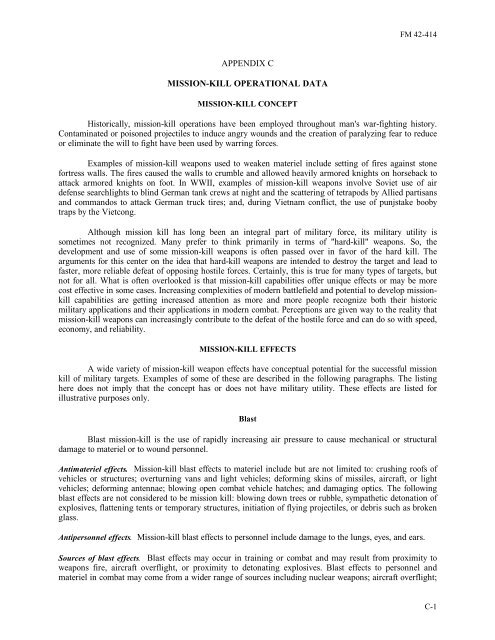Tactics, techniques, and procedures for - Army Electronic ...
Tactics, techniques, and procedures for - Army Electronic ...
Tactics, techniques, and procedures for - Army Electronic ...
Create successful ePaper yourself
Turn your PDF publications into a flip-book with our unique Google optimized e-Paper software.
APPENDIX C<br />
MISSION-KILL OPERATIONAL DATA<br />
MISSION-KILL CONCEPT<br />
FM 42-414<br />
Historically, mission-kill operations have been employed throughout man's war-fighting history.<br />
Contaminated or poisoned projectiles to induce angry wounds <strong>and</strong> the creation of paralyzing fear to reduce<br />
or eliminate the will to fight have been used by warring <strong>for</strong>ces.<br />
Examples of mission-kill weapons used to weaken materiel include setting of fires against stone<br />
<strong>for</strong>tress walls. The fires caused the walls to crumble <strong>and</strong> allowed heavily armored knights on horseback to<br />
attack armored knights on foot. In WWII, examples of mission-kill weapons involve Soviet use of air<br />
defense searchlights to blind German tank crews at night <strong>and</strong> the scattering of tetrapods by Allied partisans<br />
<strong>and</strong> comm<strong>and</strong>os to attack German truck tires; <strong>and</strong>, during Vietnam conflict, the use of punjstake booby<br />
traps by the Vietcong.<br />
Although mission kill has long been an integral part of military <strong>for</strong>ce, its military utility is<br />
sometimes not recognized. Many prefer to think primarily in terms of "hard-kill" weapons. So, the<br />
development <strong>and</strong> use of some mission-kill weapons is often passed over in favor of the hard kill. The<br />
arguments <strong>for</strong> this center on the idea that hard-kill weapons are intended to destroy the target <strong>and</strong> lead to<br />
faster, more reliable defeat of opposing hostile <strong>for</strong>ces. Certainly, this is true <strong>for</strong> many types of targets, but<br />
not <strong>for</strong> all. What is often overlooked is that mission-kill capabilities offer unique effects or may be more<br />
cost effective in some cases. Increasing complexities of modern battlefield <strong>and</strong> potential to develop missionkill<br />
capabilities are getting increased attention as more <strong>and</strong> more people recognize both their historic<br />
military applications <strong>and</strong> their applications in modern combat. Perceptions are given way to the reality that<br />
mission-kill weapons can increasingly contribute to the defeat of the hostile <strong>for</strong>ce <strong>and</strong> can do so with speed,<br />
economy, <strong>and</strong> reliability.<br />
MISSION-KILL EFFECTS<br />
A wide variety of mission-kill weapon effects have conceptual potential <strong>for</strong> the successful mission<br />
kill of military targets. Examples of some of these are described in the following paragraphs. The listing<br />
here does not imply that the concept has or does not have military utility. These effects are listed <strong>for</strong><br />
illustrative purposes only.<br />
Blast<br />
Blast mission-kill is the use of rapidly increasing air pressure to cause mechanical or structural<br />
damage to materiel or to wound personnel.<br />
Antimateriel effects. Mission-kill blast effects to materiel include but are not limited to: crushing roofs of<br />
vehicles or structures; overturning vans <strong>and</strong> light vehicles; de<strong>for</strong>ming skins of missiles, aircraft, or light<br />
vehicles; de<strong>for</strong>ming antennae; blowing open combat vehicle hatches; <strong>and</strong> damaging optics. The following<br />
blast effects are not considered to be mission kill: blowing down trees or rubble, sympathetic detonation of<br />
explosives, flattening tents or temporary structures, initiation of flying projectiles, or debris such as broken<br />
glass.<br />
Antipersonnel effects. Mission-kill blast effects to personnel include damage to the lungs, eyes, <strong>and</strong> ears.<br />
Sources of blast effects. Blast effects may occur in training or combat <strong>and</strong> may result from proximity to<br />
weapons fire, aircraft overflight, or proximity to detonating explosives. Blast effects to personnel <strong>and</strong><br />
materiel in combat may come from a wider range of sources including nuclear weapons; aircraft overflight;<br />
C-1

















